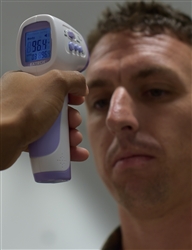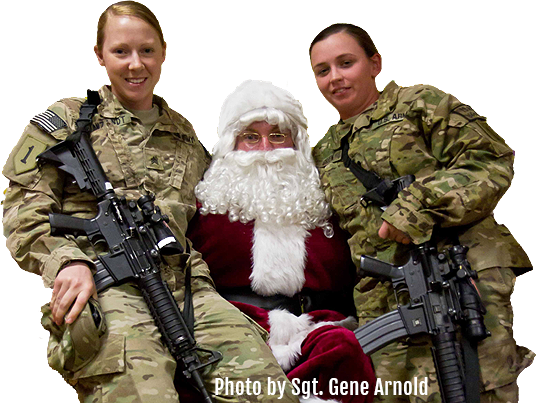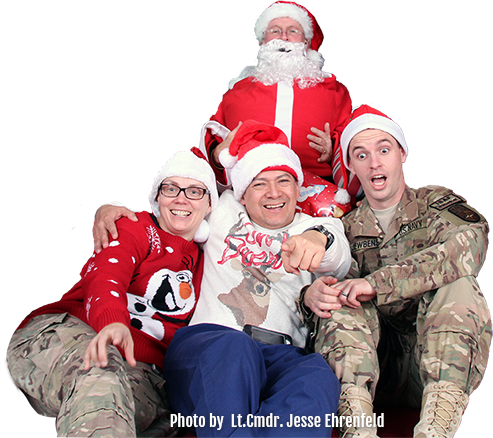 PHOTO: An airman takes a passenger’s temperature at a temporary holding facility at Ramstein Air Base. RAMSTEIN AIR BASE, Germany– As service members travel to Africa in support of Operation United Assistance, Ramstein Air Base continues to establish itself as a power projection platform for Europe and Africa. Germany, Oct. 19, 2014, after the passenger returned from West Africa. U.S. Air Force photo by Staff Sgt. Sara Keller Medical professionals from the 86th Medical Group recently implemented plans to ensure safety precautions are taken to protect the air crews, passengers and the 54,000 members of the Kaiserslautern Military Community from possible exposure to the Ebola virus.
PHOTO: An airman takes a passenger’s temperature at a temporary holding facility at Ramstein Air Base. RAMSTEIN AIR BASE, Germany– As service members travel to Africa in support of Operation United Assistance, Ramstein Air Base continues to establish itself as a power projection platform for Europe and Africa. Germany, Oct. 19, 2014, after the passenger returned from West Africa. U.S. Air Force photo by Staff Sgt. Sara Keller Medical professionals from the 86th Medical Group recently implemented plans to ensure safety precautions are taken to protect the air crews, passengers and the 54,000 members of the Kaiserslautern Military Community from possible exposure to the Ebola virus.
Exposure assessments All personnel are screened before departing from Ebola-affected areas, and those categorized as “no known exposure” or “low risk of exposure” are allowed to board Air Force aircraft bound for Ramstein. “Transient aircrew members who are on the ground for only a few hours are actually below the lowest Center for Disease Control exposure category,” said Air Force Capt. Michael D’Amore, a flight surgeon assigned to the 86th Aerospace Medical Squadron. “Additionally, airmen from the 86th Airlift Wing that are located in the areas of the Ebola outbreak are kept within secure Department of Defense areas,” D’Amore said.
“These areas are protected and monitored to prevent [persons with] active or contagious cases of Ebola from coming in contact with our airmen. Furthermore, all people within these DOD areas are monitored several times daily for any signs of symptoms,” he continued. Additionally, airmen assigned to Ramstein will be monitored upon their return, said Lt. Col. Juan Ramirez, commander of the 86th Aerospace Medicine Squadron public health flight. “Upon arrival, it is mandatory for all airmen who are stationed here to have their temperature taken twice a day by a medical professional at the Ramstein clinic for 21 days,” Ramirez said.
Ongoing screenings Because aircrew are consistently traveling in and out of these areas, they will be required to monitor their own temperatures and report them twice a week to the flight medicine clinic at Ramstein. In addition to temperature checks, the crews complete a screening process before and after they go on missions into West Africa. “Airmen are tracked and screened prior to departing and upon return,” D’Amore said. “We track countries visited and potential contact with indigenous people, animals or exotic foods.”
Trained for response Although most of the airmen from the 86th Airlift Wing traveling into infected areas are considered transient aircrew and have minimal time on the ground in places like Liberia, the aircrews are educated about and prepared to carry out the necessary protocols and procedures in the unlikely event an infected patient manifests symptoms on a U.S. Air Force aircraft. “All aircrew members have been briefed in quarterly safety meetings and since then, several Flight Crew Information Files have been distributed on the topic of Ebola,” D’Amore said. “FCIFs are mandatory documents that must be read prior to their next flight and they include information as well as procedures to protect our airmen from exposure to Ebola, prevention of the virus on U.S. Air Force aircraft, and what to do in the event of a passenger presenting symptoms while in flight.” Measures are in place to monitor transient passengers landing at Ramstein from Ebola-afflicted areas. Like aircrews, passengers will also be pre-screened before departing infected areas. “As personnel redeploy from West Africa to return to Ramstein, they’ll be screened and cleared by 86th Medical Group public health staff,” Ramirez said. Personnel transiting through Ramstein will have their temperatures taken plane-side, with further monitoring continued at their final destinations, he noted.
Supporting a larger effort In response to President Barack Obama's directive to increase the U.S. response to the Ebola epidemic, U.S. Africa Command is working with the U.S. Agency for International Development to deliver much-needed support. Part of Africom's effort is the tactical theater airlift provided by the 86th Airlift Wing, now in conjunction with the 86th Medical Group’s efforts to educate and protect airmen and the entire military community. “Containing this Ebola outbreak is a necessity on a global and national scale,” D’Amore explained. “Therefore, the airmen of the 86th [Airlift Wing] are vital for support of DoD and national efforts. It’s exciting to be a part of a large and evolving operation such as this,” he continued. “One of the main functions of medical in the military is to prevent the spread of disease throughout the fighting force, and that is a big reason why we train and prepare service members to help in this outbreak that now has international attention,” D’Amore said.
Written Oct. 22, 2014 By: Air Force Staff Sgt. Sara Keller 86th Airlift Wing
Republished and redistributed by permission of DoD.






